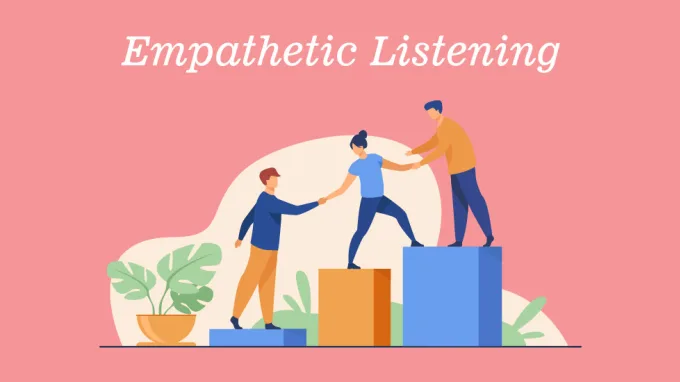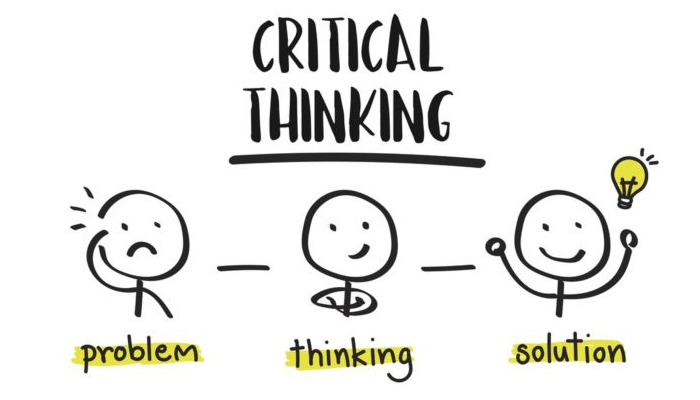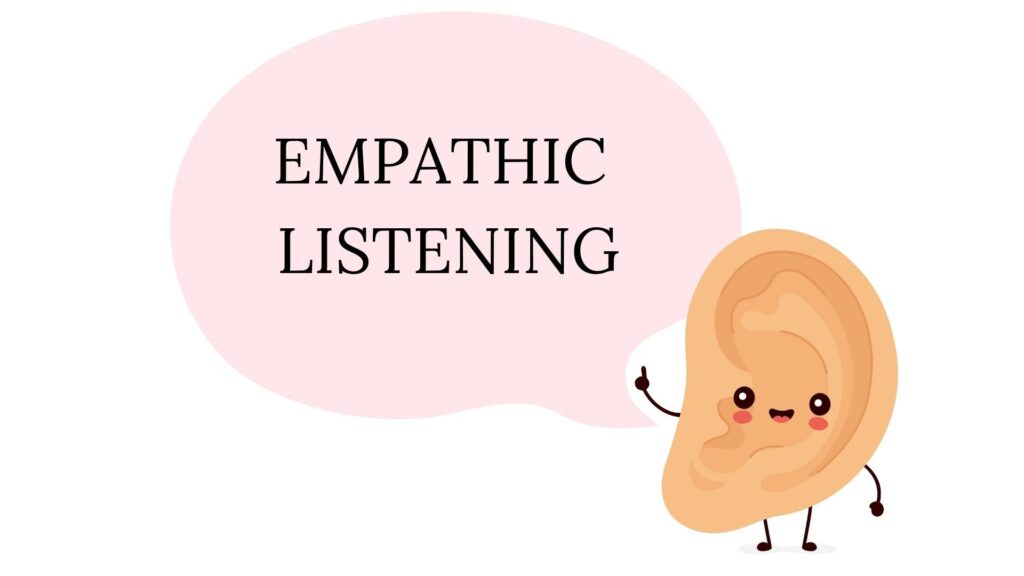Empathic listening: How to Improve it

Empathic listening is the process of making an emotional connection with someone who is speaking. This enables you to put yourself into their shoes, and feel with them—the definition of empathy.
It is therefore an extension of active listening, but requires a conscious and much stronger focus on feelings. Crucially, empathic listening gives the speaker space to feel heard and validated. It is therefore perhaps more of a therapeutic technique than active listening, which is more about supporting good two-way communication.
What is Empathic listening?
Table of Contents
ToggleEmpathic listening is a communication technique that involves listening with empathy and understanding to another person’s perspective. This approach requires you to be fully present and attentive to what the other person is saying, both verbally and non-verbally. Empathic listening is an active process that involves focusing on the speaker’s message and reflecting on their emotions and thoughts.
Characteristics of Empathic listening
There are several characteristics of empathic listening written below:
Active listening:
Active listening is a key component of empathic listening, because it requires you to give your full attention to the speaker.
This means actively engaging in the conversation, asking questions to clarify any misunderstandings.
And providing feedback to show that you’re truly listening.
Active listening helps to create a safe and supportive environment for the speaker, where they feel heard and understood.

Critical thinking:
Critical thinking is also essential for empathic listening.
It involves evaluating the speaker’s words, identifying their underlying feelings and motivations, and reflecting on the conversation from multiple perspectives.
This requires you to think beyond the surface level of what the speaker is saying, to try to understand their thoughts and emotions.
Critical thinking helps to deepen your understanding of the speaker’s perspective.

No bias, judgment-free zone:
We all have our own biases and judgments that can cloud our ability to truly listen and understand others.
To engage in empathic listening, it’s important to recognize your own biases and set them aside.
This means approaching the conversation with an open mind and avoiding making assumptions or jumping to conclusions.
Creating a bias-free, judgment-free zone is essential for fostering open and respectful communication.

Non-Judgemental:
One of the most crucial parts of being an empathic listener is that you should have to be non- Judgemental. No matter what the other person shares, you should not criticize him or her. Some things you may disagree with, or they may not go well with you. In any case, before voicing out your opinion, ask enough questions to understand the issue correctly.

Respectful Silence:
Sometimes, empathic listening requires being silent and allowing the speaker to process their thoughts or emotions. Silence can be powerful in showing support and acceptance. It refers to the intentional act of staying quiet and attentive while someone else is speaking, without interrupting or filling the silence unnecessarily. Respectful silence helps to maintain the integrity of the conversation and reduces the likelihood of miscommunication.

Benefits of Empathic listening
Empathic listening offers numerous benefits, both for the listener and the speaker, as well as for the overall quality of communication and relationships. Here are some key benefits of empathic listening:
1. Enhanced Understanding:
Empathic listening goes beyond simply hearing words; it focuses on understanding the speaker’s emotions, perspectives, and underlying motivations. This deeper understanding helps build trust and empathy between individuals.
2. Improved Relation:
When people feel genuinely listened to and understood, it strengthens their relationships. Empathic listening shows respect and validates the speaker’s experiences, fostering closer connections and mutual respect.
3. Conflict Resolution:
Empathic listening is crucial in resolving conflicts constructively. By understanding each other’s viewpoints and emotions, parties involved in a conflict can work towards finding mutually acceptable solutions.
4. Increasing Productivity:
When coworkers trust and understand each other, they typically work better as a team. When there is minimized conflict, they can spend more of the day working, resulting in greater output. Trust is built on the foundation of feeling heard and understood. Empathic listening builds trust because it demonstrates genuine interest in the speaker’s thoughts and feelings, creating a supportive environment.
5. Effective Communication:
Effective Communication is the cornerstone of successful interactions, both in personal and professional settings. It involves the clear and coherent exchange of information, ideas, thoughts, and feelings between individuals or groups. It reduces misunderstandings and allows for clearer, more meaningful exchanges of ideas and information.
6. Problem Solving:
Problem solving is a critical skill in both personal and professional contexts, involving the systematic approach to identifying challenges, analyzing them, and finding effective solutions. Workplace challenges frequently require that teammates work together to find solutions. If you have a history of trust and open sharing with your coworkers.
Difference Between Empathic and Empathetic listening


| Aspect | Empathic Listening | Empathetic Listening |
|---|
| Focus | Emphasis on understanding the speaker’s emotions, perspectives, and feelings. | Focus on understanding and sharing the speaker’s emotions and feelings. |
| Goal | To deeply connect with the speaker and validate their experiences. | To share and reflect the speaker’s emotions, showing understanding and support. |
| Process | Involves actively listening to emotions and non-verbal cues, reflecting the speaker’s emotions back, and providing a supportive environment. | Involves understanding and sharing the speaker’s emotions through verbal and non-verbal communication. |
| Application | Used in counseling, therapy, conflict resolution, and situations requiring deep emotional support. | Common in interpersonal relationships, coaching, and supportive conversations. |
| Outcome | Enhances trust, builds stronger relationships, and promotes emotional healing. | Strengthens bonds, fosters mutual understanding, and creates a supportive atmosphere. |
How to listen empathically
Listening empathically involves tuning into the speaker’s emotions, perspectives, and experiences with genuine care and understanding. Here are some steps you can take to build your empathic listening skills:
- Create a comfortable space for sharing
- Acknowledge the speaker’s feelings
- Let them guide the conversation
- Pay attention to body language
- Be encouraging
- Wait to speak
Create a comfortable space for sharing
Creating a comfortable space can also entail acting comfortable yourself. If the other participant in the conversation sees that you are calm, they might respond by calming down too. Consider practicing deep breathing so you are more present and attentive.
Giving the speaker a safe place for the discussion can make them more likely to confide in you. For instance, if you’re in an office, you can turn your computer monitors off and, if it will not disrupt business, turn off your phones.
Acknowledge the speaker’s feelings
Acknowledging the speaker’s feelings is a crucial aspect of empathic listening. When you acknowledge someone’s feelings, you validate their emotional experience and show that you are genuinely engaged and empathetic.
When listening empathically, it is important to let the other party know you are considering their feelings. Although you want to keep your input to a minimum, short phrases can indicate to the speaker that you’re aware of their emotions and believe they’re important.
For instance, you can say, “I hear you” or “I see that this brings up strong emotions.”
Pay attention to body language
The speaker may indicate discomfort with their posture and mannerisms. For instance, if they’re tapping their feet or not sitting up straight, they may be nervous. Consider responding to this with more affirmations, maintaining a confident posture and speaking slowly and calmly.
Gestures like nodding or shaking the head can reinforce or contradict spoken words. Overall, paying attention to body language helps decipher the full message someone is conveying, enhancing effective communication and empathy.
Wait to Speak
When you wait to speak, you are giving your full attention to the speaker, which shows respect and helps you understand their perspective better. This approach fosters more meaningful and effective communication, as it allows for thoughtful responses rather than reactive ones. By waiting to speak, you create a more engaging and respectful dialogue, where all parties feel heard and valued.
Holding your opinions until the other party asks for them demonstrates that you value their input and respect their wishes. If, after sharing, the speaker says, “What do you think?” you may offer your opinion. Otherwise, it is likely best to simply listen and give small acknowledgments.
Be encouraging
Being encouraging in your interactions can have a profound impact on those around you. When you offer words of support and positivity, you inspire confidence and motivation in others. Whether it’s acknowledging someone’s effort, celebrating their achievements, or offering a kind word during challenging times, your encouragement can uplift their spirits and reinforce their belief in themselves.
If someone is confiding in you, it may be because they are struggling with something that they don’t know how to manage. If and when the other party asks for your input, you can encourage them by saying “I believe you can respond to this situation”.
And “I can see that you’re kind and considerate and I think that will help you manage this challenge.” With effective encouragement, your conversation partner may feel more confident in the present situation and others going forward.
Qualities of an Empathic listener
Empathic listening is a vital skill that involves truly understanding and connecting with the speaker.
1) Attentiveness: An empathic listener gives their full attention to the speaker, maintaining eye contact, and avoiding distractions. This shows that they value what the speaker is saying.
2) Non-judgmental: They listen without making judgments or jumping to conclusions, creating a safe space for the speaker to express themselves freely.
3) Patience: They allow the speaker to share their thoughts and feelings at their own pace, without interrupting or rushing them.
4) Active listening: This involves nodding, making affirmative sounds, and occasionally summarizing what the speaker has said to show understanding and engagement.
5) Open-mindedness: An empathic listener is open to new ideas and perspectives, even if they differ from their own, and they seek to understand the speaker’s point of view fully.
6) Emotional intelligence: They are attuned to the speaker’s emotions and respond with appropriate empathy and sensitivity, acknowledging their feelings.
